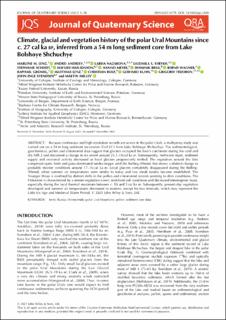| dc.contributor.author | Lenz, Marlene M. | |
| dc.contributor.author | Andreev, Andrei | |
| dc.contributor.author | Nazarova, Larisa | |
| dc.contributor.author | Syrykh, Liudmila S. | |
| dc.contributor.author | Scheidt, Stephanie | |
| dc.contributor.author | Haflidason, Haflidi | |
| dc.contributor.author | Meyer, Hanno | |
| dc.contributor.author | Brill, Dominik | |
| dc.contributor.author | Wagner, Bernd | |
| dc.contributor.author | Gromig, Raphael | |
| dc.contributor.author | Lenz, Matthias | |
| dc.contributor.author | Rolf, Christian | |
| dc.contributor.author | Kuhn, Gerhard | |
| dc.contributor.author | Fedorov, Grigoriy | |
| dc.contributor.author | Svendsen, John Inge | |
| dc.contributor.author | Melles, Martin | |
| dc.date.accessioned | 2022-03-23T14:06:14Z | |
| dc.date.available | 2022-03-23T14:06:14Z | |
| dc.date.created | 2022-01-27T15:34:13Z | |
| dc.date.issued | 2021 | |
| dc.identifier.issn | 0267-8179 | |
| dc.identifier.uri | https://hdl.handle.net/11250/2987134 | |
| dc.description.abstract | Because continuous and high-resolution records are scarce in the polar Urals, a multiproxy study was carried out on a 54 m long sediment succession (Co1321) from Lake Bolshoye Shchuchye. The sedimentological, geochemical, pollen and chironomid data suggest that glaciers occupied the lake's catchment during the cold and dry MIS 2 and document a change in ice extent around 23.5–18 cal ka bp. Subsequently, meltwater input, sediment supply and erosional activity decreased as local glaciers progressively melted. The vegetation around the lake comprised open, herb and grass-dominated tundra-steppe until the Bølling-Allerød, but shows a distinct change to probably moister conditions around 17–16 cal ka bp. Local glaciers completely disappeared during the Bølling-Allerød, when summer air temperatures were similar to today and low shrub tundra became established. The Younger Dryas is confined by distinct shifts in the pollen and chironomid records pointing to drier conditions. The Holocene is characterised by a denser vegetation cover, stabilised soil conditions and decreased minerogenic input, especially during the local thermal maximum between c. 10 and 5 cal ka bp. Subsequently, present-day vegetation developed and summer air temperatures decreased to modern, except for two intervals, which may represent the Little Ice Age and Medieval Warm Period. | en_US |
| dc.language.iso | eng | en_US |
| dc.publisher | Wiley | en_US |
| dc.rights | Navngivelse-Ikkekommersiell 4.0 Internasjonal | * |
| dc.rights.uri | http://creativecommons.org/licenses/by-nc/4.0/deed.no | * |
| dc.title | Climate, glacial and vegetation history of the Polar Ural Mountains since early MIS 2 inferred from a 54-m-long sediment core from Lake Bolshoye Shuchye | en_US |
| dc.type | Journal article | en_US |
| dc.type | Peer reviewed | en_US |
| dc.description.version | publishedVersion | en_US |
| dc.rights.holder | Copyright 2021 John Wiley & Sons, Ltd | en_US |
| cristin.ispublished | false | |
| cristin.fulltext | postprint | |
| cristin.qualitycode | 1 | |
| dc.identifier.doi | 10.1002/jqs.3400 | |
| dc.identifier.cristin | 1991575 | |
| dc.source.journal | Journal of Quaternary Science | en_US |
| dc.identifier.citation | Journal of Quaternary Science. 2021 | en_US |

